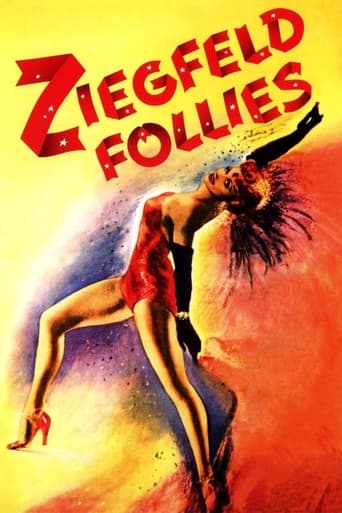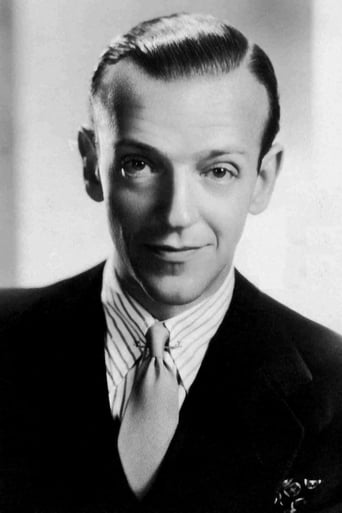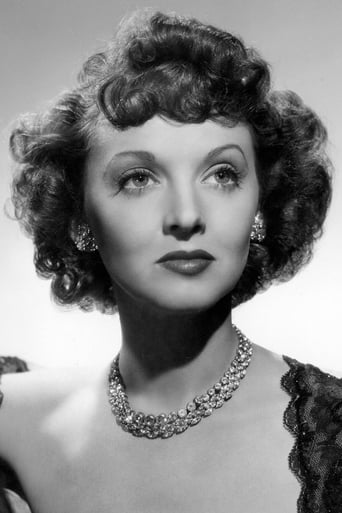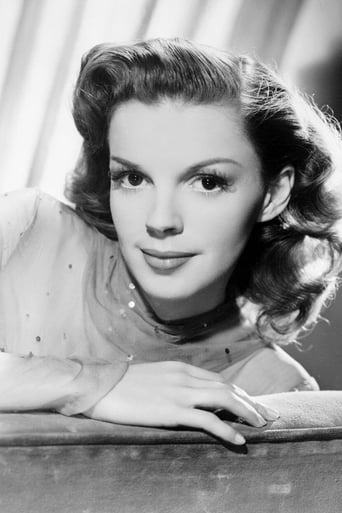Inclubabu
Plot so thin, it passes unnoticed.
Huievest
Instead, you get a movie that's enjoyable enough, but leaves you feeling like it could have been much, much more.
CrawlerChunky
In truth, there is barely enough story here to make a film.
Micah Lloyd
Excellent characters with emotional depth. My wife, daughter and granddaughter all enjoyed it...and me, too! Very good movie! You won't be disappointed.
mark.waltz
When you open up a movie musical revue with William Powell repeating his "The Great Ziegfeld" role of Flo ("What mother calls a boy Florenz?", to quote Kay Medford in "Funny Girl") imagining from heaven what he could do in cinema with his glorious glorification of the American girl. He brings out Fred Astaire, who ironically never appeared on Broadway in the "Follies" but was a stage star at the time none the less, and the "Bring on the Beautiful Ladies" is so gloriously filmed in Technicolor, the show is off to a sizzling start, whip cracking when all of a sudden Lucille Ball appears. Then, comic deadpan Virginia O'Brien burlesques it with her search for "those glorious men". Comic routines, operetta numbers and a few big song and dance numbers follow, many mediocre but a few classic.The highlights for me are Fred joining Gene Kelly for "The Babbit and the Bromide", Lena Horne with "Love" and "This Heart of Mine" with Lucille Bremer whom Astaire had scored artistically with, if not financially with, in the underrated "Yolanda and the Thief" (actually filmed after this). An Asian themed number with the two of them is not as successful, and Judy Garland's "The Great Lady Has an Interview" is unfortunately extremely dated and sometimes rather aggravating. Moments of it shine, but it takes a long while for the number to get rolling.The comedy routines are not for today's audiences unless they are into nostalgia, as I am. Red Skelton's "Guzzler's Gin" will bring on as much of a gag reflex for some as the gin did for him, but there are moments of it that are truly hysterical. "The Lottery Ticket" routine features Fanny Brice in her only film after "Everybody Sing" and teams her with dramatic Hume Cronyn and funny man William Frawley. "Pay the Two Dollars" is the nadir of the comic routines, even if it has the adorable Victor Moore, another veteran star of the Broadway musical.The controversial "There's Beauty Everywhere" had director Vincent Minnelli exclaiming, "You Can't Direct Bubbles!", and sure, that is definitely true, but it is gorgeous to watch, and Kathryn Grayson sings it beautifully. Ms. Grayson once told a story to an audience (where I was present) about making this number where she explained how she was crying after watching the dailies and all of a sudden heard the buzz-saw voice of Katharine Hepburn telling her that it wasn't all that bad. And that it isn't, certainly not something you would have seen in an actual "Ziegfeld Follies", but worthy of MGM's Freed unit, and a camp classic to boot.
MartinHafer
There are two main sorts of musical fans--those who really want to see singing and dancing and those who want a plot as well as SOME singing and dancing. I am definitely in the latter category and absolutely demand a strong plot to anchor the film. Because of this, "Ziegfeld Follies" is exactly the sort of film I do NOT like, as there really is no plot. It's much more like an MGM talent show with one skit after another tacked together. Each segment stands on its own and is either a BROAD comedy skit or a musical number.The film begins with what is supposed to be a plot--but it really isn't incorporated into the rest of the movie. The film begins in Heaven--with Flo Ziegfeld thinking how great it would be if he could do one last show--then the skits follow. They are all very pretty--with lovely sets, top actors and vivid color. But, on the other hand, none of the many segments is particularly good. No plot--just a nice looking MGM talent show.If you don't care about a complete absence of plot and don't mind watching second-rate dancing and singing and third-rate comedy, then by all means watch "Ziegfeld Follies". However, MGM made many, many musicals that are simply better--and with engaging plots. Not exactly my sort of film.By the way, there is an Esther Williams swimming number in this film that is SUPPOSED to be a stage show. How in the heck could ANY audience sitting in a theater really see an Esther Williams dance number?! This has always perplexed me about a lot of her films, as there is no way the audience could even see most of the water ballet in these numbers unless they are up on stage or sitting in the rafters!
jotix100
"Ziegfeld Follies" an MGM feature from 1945 was shown recently on cable. This film was a sort of revue that combine comedy and music and showcased the stars under contract with the studio. If musicals were to succeed, they usually came from the folks that knew how to do this genre with style, which is the case of this entertaining movie.Fred Astaire shows up in a couple of segments paired with Louise Bremer, a new partner for him. Mr. Astaire does what he did best: dance to his heart content. There is also a duet with Gene Kelly, another dancer who went to make a career in the studio. The dancing sequences are about the best things in the film. The other highlight is Judy Garland in "A Great Lady Has An Interview", directed by none other than Vincente Minelli. The number shows Ms. Garland in all her splendor in a number that is quite a departure for her. Ms. Garland had a sweetness that came through easily in front of the camera, something that appeared to be a natural gift.There are some funny skits involving Victor Moore, Fanny Brice, Hume Cronyn, William Frawley, Red Skelton, Edward Arnold, among others. Lovely Lena Horne makes a wonderful appearance singing "Love". Even Esther Williams, another MGM star has a chance to do some swimming. William Powell shows up as Florenz Ziegfeld.Directors included George Sidney, Roy Del Ruth, Vincente Minelli, Charles Waters, Lemuel Ayers, Robert Lewis and Merrill Pye. The stable of writers of MGM contributed to make this a special film to be treasured.
Steffi_P
Although Florenz Ziegfeld only ever worked on the stage, his influence over Hollywood in its golden age was considerable. Not only were many of the early talkie stars Ziegfeld veterans, his extravagant musical numbers also left their mark in the work of Busby Berkeley or the "ballet" sequences of 40s and 50s musicals. His shows really epitomised grand style for its own sake. So when MGM wanted to splash out on a lavish burst of post-war indulgence, what better than a modern day re-imagining of a Ziegfeld Follies revue, just as the great man might have envisaged it himself? Like the original shows after which they are named, Ziegfeld Follies presents a sequence of acts with no linking plot, only a continuous aim to dazzle and entertain in a variety of ways. After a rather twee preamble with William Powell as a heavenly Ziegfeld, interspersed with some nice puppetry, the opening musical number closely follows the style and ethos of the Follies, with row upon row of elegant chorus girls bedecked in over-the-top period costumes. Its call of "Here's to the Girls" is a clear homage to Ziegfeld's own "Glorifying the American Girl". Directed in a somewhat presentational style by George Sidney, it takes us back to the experience of seeing an original Follies from thirty years earlier. The second number however features something Ziegfeld could never have done justice on the stage – Esther Williams doing her mermaid ballet act. From here on the style is consistently cinematic, and it becomes clear this is more than anything else a display of modern MGM talent and the scope of musical cinema.Nowhere is this more evident than in the five numbers directed by Vincente Minnelli. Minnelli, an incredibly musically sensitive filmmaker, was able probably better than anyone else to make the camera part of the choreography. He will pull backwards so that dancers appear from the foreground, sliding softly into view without moving much themselves. There are moments in the drinking song from La Traviata where branches are whipped on and off the screen to balance out the shot as the dancing couple turns, a move only making sense in the context of the movie frame that would be ineffective on a stage. In the final number, "Beauty", most of the performers do not even move at all, the lens slinking rhythmically over them. However Minnelli is also sensible enough to know when to settle down and simply let a dance play out, but even here the specific angle and composition are delicately precise. Cinematic techniques such as close-ups on jewellery in "This Heart of Mine", or the shots in "Limehouse Blues" from inside the bric-a-brac shop allow a certain intimate storytelling not normally possible in dance, and even make these two numbers rather poignant. I should point out by the way that not too much should be read into Mr Minnelli's association with the excellence of these segments, since it follows that as MGM's best musical director he would be assigned to the best and biggest numbers anyway.The handful of non-musical comedy sketches are by far the weakest elements of Ziegfeld Follies. They feature some pretty fine comedy actors, with newcomers like Keenan Wynn and Red Skelton alongside old hands like Victor Moore and Fanny Brice, representing one of the few links to the original Follies. But no matter how well played it is, each sketch runs as little more than a handful of feeble jokes stretched to breaking point, plus a lot of face-pulling. I think the main problem is that it's movie humour, the sort that only works as a comic relief subplot when woven into a larger narrative. These film writers weren't used to the sketch format. As an example of the difference, Keenan Wynn was excellent when he turned up for two minutes in The Clock (also 1945), but here he is an embarrassment. By the way, the camp Texan in Wynn's sketch is Grady Dutton. He had bit parts in dozens of pictures over the years, most of them fleeting but always memorable.Perhaps unsurprisingly, the few comedy moments that really do work are those which take place within musical numbers. "The Great Lady has an Interview" is one of the earliest examples of Judy Garland's comedic talents, while "The Babbitt and the Bromide" shows Fred Astaire and Gene Kelly at their most playful (as well as featuring some great sight-gags with that horse statue in the background). Of course part of the secret of these numbers is that they merge the comedy with the glamour and musicality. But they both also happen to be numbers which satirize the movie industry itself. Judy Garland's act is a gentle poke at dramatic actresses (especially Greer Garson) moving to more raunchy roles, and she has great fun playing up the self-absorbed luvvy stereotype. Astaire and Kelly lampoon their own screen images, slyly referencing Kelly's status as an up-and-comer, and even dancing a little waltz together (although, if you look closely, being very careful not to quite hold each other's hands properly). Ziegfeld Follies once again proves itself to be a product of and about the cinema. The title and outline may be Ziegfeld's, but the spirit belongs to MGM.





